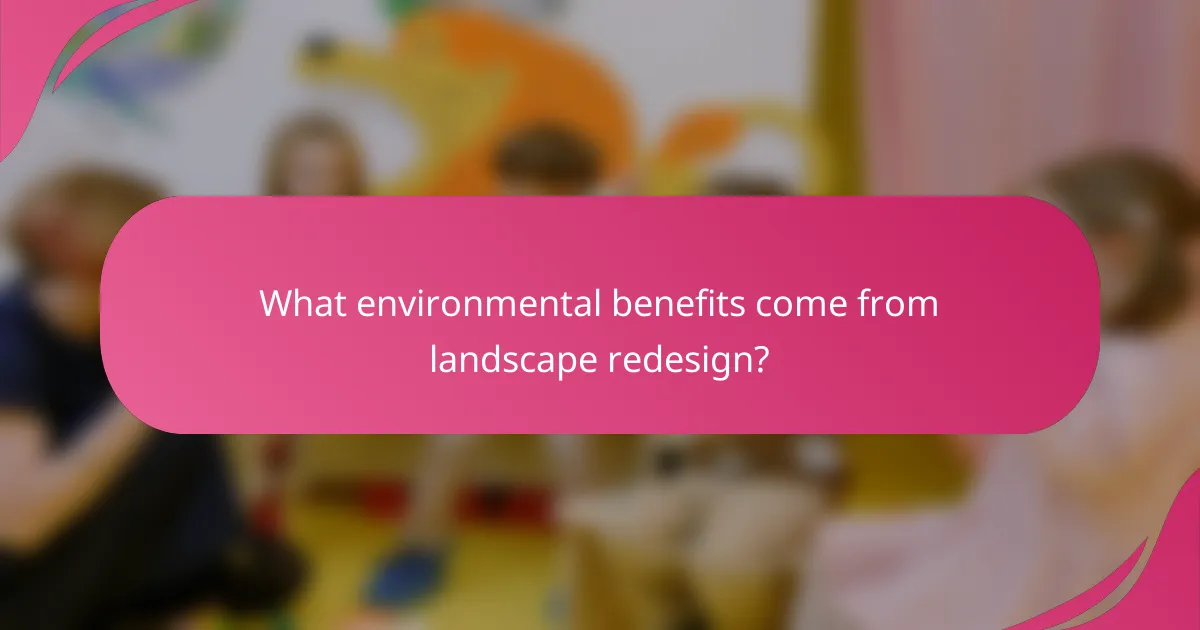Landscape redesign plays a crucial role in enhancing outdoor enjoyment, property value, and environmental sustainability. By creating inviting and functional outdoor spaces, homeowners can enjoy recreational activities while simultaneously increasing the aesthetic appeal and marketability of their properties. Additionally, thoughtful landscaping promotes biodiversity and supports local ecosystems, contributing to a healthier environment for all.

How does landscape redesign enhance outdoor enjoyment in Canada?
Landscape redesign significantly enhances outdoor enjoyment in Canada by creating inviting spaces that encourage outdoor activities and relaxation. Thoughtful planning can transform yards into functional areas that cater to various recreational needs while improving the overall ambiance.
Increased recreational space
Redesigning landscapes can expand available recreational space, making yards more functional for activities like gardening, playing, or simply lounging. Consider incorporating features such as patios, decks, or open lawns to maximize usability.
Creating designated zones for different activities can help organize the space effectively. For example, a grassy area for children to play can coexist with a serene garden retreat for adults.
Improved aesthetics
A well-designed landscape enhances the visual appeal of a property, making it more attractive to both residents and visitors. Incorporating elements like colorful flowers, varied textures, and strategic lighting can create a stunning outdoor environment.
Using local materials and plants not only boosts aesthetics but also ensures that the landscape blends harmoniously with the surrounding environment. This can lead to a cohesive look that reflects the natural beauty of Canada.
Enhanced privacy
Landscape redesign can significantly improve privacy by strategically placing trees, shrubs, and fences. Dense plantings can act as natural barriers, shielding outdoor spaces from neighbors and street view.
Consider using tall hedges or privacy screens to create secluded areas for relaxation or entertainment. This can make outdoor spaces feel more intimate and inviting.
Outdoor entertainment areas
Creating dedicated outdoor entertainment areas can enhance social gatherings and family time. Features like patios, fire pits, and outdoor kitchens encourage people to spend more time outside.
Incorporating comfortable seating and weather-resistant furniture can make these spaces more inviting. Consider adding amenities like lighting and sound systems to elevate the outdoor experience.
Native plant integration
Integrating native plants into landscape redesign not only supports local wildlife but also reduces maintenance needs. Native species are adapted to the local climate and soil, making them more resilient and easier to care for.
Choosing plants that thrive in Canadian conditions can lead to a sustainable landscape that requires less water and fewer chemicals. This approach also contributes to biodiversity and helps preserve local ecosystems.

What is the impact of landscape redesign on property value?
Landscape redesign can significantly enhance property value by improving aesthetics and functionality. A well-planned outdoor space not only attracts potential buyers but can also lead to higher offers when selling a home.
Higher resale prices
Investing in landscape redesign often results in higher resale prices for properties. Studies suggest that well-maintained gardens and outdoor spaces can increase a home’s value by a notable percentage, sometimes ranging from 10% to 20%. This increase is particularly evident in areas where outdoor living is highly valued.
To maximize resale potential, focus on features like native plants, patios, and outdoor lighting, which appeal to buyers looking for functional and attractive spaces.
Increased curb appeal
Enhanced curb appeal is a direct benefit of landscape redesign, making properties more inviting. A well-designed front yard can create a positive first impression, which is crucial in attracting potential buyers. Simple improvements, such as fresh mulch, trimmed hedges, and colorful flowers, can significantly elevate the visual appeal.
Consider incorporating elements like pathways, decorative borders, and seasonal plantings to maintain attractiveness throughout the year, further boosting curb appeal.
Marketability in urban areas
In urban areas, landscape redesign can greatly improve marketability by providing a much-needed escape from concrete surroundings. Properties with thoughtfully designed outdoor spaces are often more desirable, as they offer residents a chance to enjoy nature without leaving the city.
Urban dwellers typically seek features like rooftop gardens, balcony plants, and community green spaces. Incorporating these elements can make a property stand out in a competitive market, attracting buyers willing to pay a premium for outdoor enjoyment.

What environmental benefits come from landscape redesign?
Landscape redesign offers several environmental benefits, including enhanced biodiversity, better stormwater management, reduced carbon footprints, and improved soil health. These changes not only support local ecosystems but also contribute to a more sustainable environment.
Improved biodiversity
Redesigning landscapes can significantly boost biodiversity by incorporating native plants and creating habitats for various species. Native plants are adapted to local conditions and provide food and shelter for local wildlife, including birds, insects, and small mammals.
To enhance biodiversity, consider planting a diverse array of species that bloom at different times throughout the year. This ensures a continuous food source for pollinators and other wildlife, fostering a balanced ecosystem.
Stormwater management
Effective landscape redesign can improve stormwater management by utilizing permeable surfaces and rain gardens that absorb excess water. This reduces runoff, which can lead to erosion and water pollution in nearby streams and rivers.
Incorporating features like swales or bioswales can help direct water flow and promote natural filtration. Homeowners should aim to create landscapes that allow for at least 30-50% of rainfall to be absorbed on-site, minimizing the impact on local drainage systems.
Carbon footprint reduction
Landscaping can play a role in reducing carbon footprints by increasing green spaces that sequester carbon dioxide. Trees and shrubs capture CO2 during photosynthesis, which helps mitigate climate change effects.
To maximize carbon capture, select fast-growing tree species that thrive in your area. A well-placed tree can absorb around 48 pounds of CO2 annually, making strategic planting an effective way to contribute to environmental sustainability.
Soil health enhancement
Landscape redesign can enhance soil health through practices like mulching, composting, and planting cover crops. These methods improve soil structure, increase organic matter, and promote beneficial microbial activity.
Incorporating organic materials into the soil can boost its nutrient content and water retention capabilities. Aim for a soil organic matter level of at least 5% to support healthy plant growth and reduce the need for chemical fertilizers.

What are the key considerations for landscape redesign in Canada?
Key considerations for landscape redesign in Canada include climate adaptability, local zoning regulations, and soil quality assessment. Each of these factors plays a crucial role in ensuring that outdoor spaces are not only aesthetically pleasing but also functional and sustainable.
Climate adaptability
Climate adaptability is essential for landscape redesign in Canada due to its diverse weather conditions, ranging from cold winters to warm summers. Selecting native plants that can withstand local climate variations helps ensure longevity and reduces maintenance costs.
Consider incorporating features such as rain gardens or permeable paving to manage stormwater effectively. These elements not only enhance the landscape but also support local ecosystems by promoting biodiversity.
Local zoning regulations
Understanding local zoning regulations is critical when planning a landscape redesign. These regulations dictate what can be built, where, and how, which can impact design choices significantly. For example, some areas may have restrictions on fence heights or the types of structures allowed in front yards.
Before starting a project, check with municipal offices or local planning departments to ensure compliance with zoning laws. This can prevent costly modifications or delays during the redesign process.
Soil quality assessment
A soil quality assessment is vital for successful landscape redesign, as it determines the health and fertility of the ground where plants will grow. Testing soil pH, nutrient levels, and drainage capabilities can inform plant selection and landscaping techniques.
Consider conducting a soil test through local agricultural extension services or gardening centers. Based on the results, you may need to amend the soil with organic matter or fertilizers to create an optimal growing environment for your chosen plants.

How to choose the right plants for landscape redesign?
Selecting the right plants for landscape redesign involves considering factors such as climate, soil type, and maintenance needs. Prioritize plants that thrive in your local environment to enhance outdoor enjoyment, boost property value, and provide environmental benefits.
Native species selection
Choosing native species is crucial for a successful landscape redesign. Native plants are adapted to local conditions, requiring less water and maintenance while supporting local wildlife. For instance, in the United States, options like coneflowers and black-eyed Susans are popular choices that attract pollinators.
To select native plants, research your region’s flora through local extension services or native plant societies. This ensures that your landscape not only looks beautiful but also contributes to the local ecosystem.
Drought-resistant options
Drought-resistant plants are essential for sustainable landscaping, especially in areas prone to dry conditions. These plants require minimal irrigation once established, helping conserve water and reduce maintenance costs. Examples include succulents, lavender, and ornamental grasses.
When selecting drought-resistant options, consider grouping plants with similar water needs together. This technique, known as hydrozoning, maximizes water efficiency and promotes healthier plant growth.
Seasonal interest plants
Incorporating seasonal interest plants adds visual appeal throughout the year. Choose a mix of perennials, annuals, and shrubs that bloom at different times to ensure your landscape remains vibrant. For example, tulips and daffodils can provide spring color, while asters and chrysanthemums can brighten the fall.
To maintain continuous interest, plan your plantings in layers, combining early bloomers with late-season varieties. This strategy not only enhances aesthetics but also supports a diverse habitat for wildlife year-round.

What are the costs associated with landscape redesign?
The costs associated with landscape redesign can vary significantly based on the scope of the project, materials used, and professional services engaged. Homeowners should expect to invest anywhere from a few hundred to several thousand dollars, depending on their goals and the complexity of the redesign.
Initial Consultation and Design Fees
Initial consultation and design fees typically range from $50 to $200 per hour, depending on the landscape designer’s experience and location. Some designers may offer flat-rate packages that include site analysis and conceptual designs. It’s essential to clarify these costs upfront to avoid surprises later.
Materials and Plant Costs
Materials and plants can account for a significant portion of the total redesign cost. Basic landscaping materials like mulch, soil, and stones can cost between $50 to $300, while mature trees and shrubs may range from $20 to over $500 each. Selecting native plants can reduce costs and maintenance in the long run.
Labor Costs
Labor costs for landscape redesign can vary widely, generally falling between $30 and $100 per hour. For larger projects, some contractors may offer a flat fee based on the estimated time and materials required. Always get multiple quotes and check references to ensure quality work.
Maintenance Costs
After the redesign, ongoing maintenance is essential to keep the landscape looking its best. Homeowners should budget for regular upkeep, which can range from $100 to $500 per month, depending on the size and complexity of the landscape. Consider hiring a professional service or investing time in DIY maintenance to manage costs effectively.


